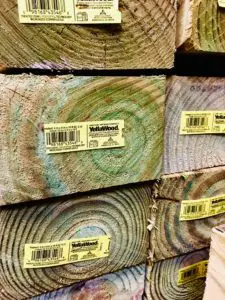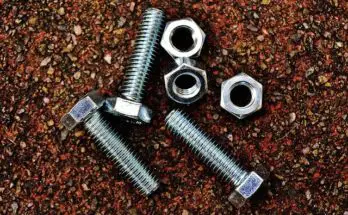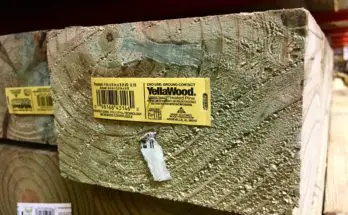If you are looking to build a new outdoor structure, it’s likely (and suggested) that you look using pressure treated wood. Pressure treated wood was first designed back in the 1960’s. For many decades, it was the only option available for homeowners and builders. In recent years, more options have become available such as composite wood. Pressure treated wood is still a favorite to use due to it’s cost, but there are some scenarios where you should not sure pressure treated wood. We will cover that and much more in the article below.
What is Pressure Treated Wood?
Pressure treated wood was invented back in the 1960’s. The process involved forcing a solution of water and chemicals into the wood at very high pressure. The three most common chemicals that are injected into the wood are: copper azole, alkaline copper quaternary or micronized copper azole.
As the water from the treatment dries out, the chemicals stay behind and help preserve the wood and significantly increase the life of the wood.
What are the benefits of Pressure Treated Wood?
Many benefits exist in using pressure treated wood in your next outdoor project. Pressure treated wood does an excellent job of defending against termites, rot and decay which can destroy untreated wood very quickly when exposed to outdoor elements.
Another benefit to using pressure treated wood is the cost. It is significantly cheaper to purchase pressure treated boards over other water and disease resistant species of woods such as cedar and redwood.
Due to it’s popularity, it is very easy to find pressure treated wood in all big box stores. It’s also comes in many different sizes unlike more specialized species of woods.
What is the Life Span of Pressure Treated Wood?
Depending on the source, you’ll see wide ranges of lifespans listed for pressure treated wood. Many makers of pressure treated wood claim that it can last up to 40 years. This is true in perfect scenarios.
 The more likely life expectancy for pressure treated wood used on a deck or fence is around 10-12 years.
The more likely life expectancy for pressure treated wood used on a deck or fence is around 10-12 years.
Pressure treated wood is great to use outdoors and it does protect against rot, insects and mold. However, it doesn’t protect against water! Water will seep into the boards if they aren’t sealed properly each year. When water gets down into the wood, it can cause warping and cracking which fast track the wood to more problems.
I highly recommend performing some preventative maintenance to your pressure treated wood each year to ensure you get the most life out of it as possible.
Painting and Staining Pressure Treated Wood
There’s a lot of confusion when it comes to whether you can paint and/or stain pressure treated wood. This is likely due to the extremely high moisture content of pressure treated wood when you initially buy it. Most people assume that it’s not possible to apply paint or stain to a material that is so wet. This isn’t true, if you take the proper steps to prepare the wood. We’ll cover that in the sections below.
What is the Best Pressure Treated Wood Primer?
Using a primer on your pressure treated wood is a great way to not only help seal the wood, but also ensure that the paint adheres to the wood appropriately. When looking for a primer, make sure you look for one that is rated for outdoor use, because not all of them are. The primer I most commonly use on pressure treated wood is made by Kilz. You can find it here: (Amazon Link).
This particular type of Kilz will work indoors and outdoors. It also have a very low VOC. it also performs well in high humidity areas.
Can you Stain or Paint Pressure Treated Wood?
Absolutely! Pressure treated wood can be stained or painted just like untreated lumber. The key to getting good results is to ensure that it has dried sufficiently, which we’ll cover below.
If you are trying to decide whether you want to stain or paint your pressure treated wood, I would suggest going with stain. Typically, when pressure treated wood is painted, it will peel, crack or flake over time which will cause more time for upkeep, especially if you don’t use a primer beforehand.
Staining pressure treated wood is easier and it holds up much better over time.
Check out my article “Can I use Pressure Treated Wood inside my Home” if you are interested in using it for indoor projects!
If you do decide to stain your project, I highly suggest using TWP branded stain (Amazon Link). The big box stores carry other brands that you are probably more familiar with; however, when I stained my deck I did a very detail study on the various brands of stains so I wouldn’t have to do the project again anytime soon.
I’ve been very pleased with how TWP has withstood the elements. It’s responded great to our cold winters and extremely hot and humid summers.
One additional suggestion – If you have a large area to stain, like a deck or fence, make sure to invest in a good brush. This will save you lots of time and frustration. I used this particular one (Amazon Link) by Perdura and was impressed with it.
How to Dry Pressure Treated Wood Quickly?
Pressure treated wood is often very wet when you buy it from the store. This is due to the chemicals that have been applied to the lumber to increase it’s durability. Before you can apply any stains or paint to the wood, it’s important that you ensure it has dried sufficiently.
Unfortunately, getting pressure treated wood to dry quickly is not a quick process.
 There’s basically two ways, you can speed up the drying process for pressure treated wood. One will take some effort to construct, while the second option will take time.
There’s basically two ways, you can speed up the drying process for pressure treated wood. One will take some effort to construct, while the second option will take time.
The first option is to create a kiln. Although it sounds like a big project, you can make a basic one to accomplish what you need. You can find a number of videos on Youtube on how people construct them.
All kilns operate the same way. Basically, you’re placing your wood into an enclosed area and pushing dry heat into it to get it above the local air temperature. It’s also important to ensure there is proper spacing between all of your boards so air can flow freely between the boards and evenly dry the boards.
The second, and more common option to drying out pressure treated boards quickly, is to simply lay them out on a flat surface and let them air dry. It is important to put small spacers (scrap wood works fine) between the boards to ensure they can good airflow.
This method works best when it is warm outside and there’s low humidity. The method works even better if you can place the boards in full direct sunlight. I’ve even gone as far and turning the boards over every couple days to ensure both sides get good sunlight.
Depending on weather conditions, you’ll need to let the boards dry for at least 3-4 days using this method. If rain is in the forecast, I recommend covering the boards with a piece of tarp or plastic.
One thing to keep in mind, is that if your wood dries too quickly, it will likely suffer from something that is referred to as “checking.” This is another word for cracking. Further down, I’ll go over the best way to avoid checking and what you should do if it occurs.
Since neither of these methods are quick and easy, I highly suggest buying any pressure treated boards that you are going to need a couple weeks in advance. This will help ensure that your wood has plenty of time to dry when it comes time to using it in your project.
How to tell if Pressure Treated Wood is Dry?
Checking to see if your pressure treated wood is dry enough for paint or stain is actually very easy. Get a spray bottle and spray a small amount of water onto a piece of pressure treat wood. If you don’t have a spray bottle, you can also just get some water on your finger tips and flick it onto the board.
If the wood soaks the water up – it’s dry enough to stain or paint.
If the water beads together or sits on top of the wood – your wood still needs more time to dry.
Check out my article here to get the full details on whether or not you can use Pressure Treated wood in your garden and raised beds!
What is the Best Pressure Treated Wood Cut Sealer?
Wood, no matter the type, is most susceptible to damage when the ends are expose to moisture. The ends are where wood absorbs the most amount of water and liquids. This is easy to see when staining a piece of wood. As you apply stain to the ends, it gets soaked into the wood much quicker than on the sides.
Even though pressure treated wood is designed to stand up to the outdoor elements. You can always do a little more to product and boards that you’ve cut. There’s one product that has been around for decades that does an excellent job of helping your wood hold up to the outdoor elements.
It is called Anchorseal. You can buy it on Amazon by clicking here. The manufacture states that by applying Anchorseal, you can prevent up to 90% of checking (cracking) that occurs on the end of boards. Taking the time to seal your the ends of your boards with a product like Anchorseal not only protects the wood against possible rot and decay down the road, but it also helps keeping the boards looking great. The other nice thing about Anchorseal is that it dries clear, which is why it’s a preferred product by many.
Why does Pressure Treated Wood suffer from Checking (or cracking)?
In the lumber industry, when wood dries too quickly and cracks form, the result is called “checking.” Checking is very common with pressure treated wood due to how wet it is when purchased due to water and chemicals being  pressed into the wood.
pressed into the wood.
The only way to avoid checking is to dry your lumber slowly and evenly. The best way to avoid checking is to store your pressure treated wood in a garage or somewhere away from the outdoor elements and give it several months to dry out on it’s own. When stacking the wood indoors, it’s very important to space the wood and not lay it directly upon other boards to ensure the wood dries evenly. A piece of scrap wood can easily serve as a wood spacer.
If you are short on time or space and you are not able to wait for your wood to thoroughly dry, you’ll need to expect that it will crack about 6-12 months after installing it outdoors. Generally speaking, these cracks won’t harm the structural integrity of your project. However, it is suggested that you take steps to add sealant to these cracks as preventative maintenance to ensure the opened areas don’t open the wood up to decay or rot. Even though pressure treated wood helps fight rot and decay, it can (and will) still happen if the wood isn’t cared for.
Fortunately, there are several sealants on the market and they product great results. My favorite sealer is produced by Anchorseal. You can find it on Amazon (Click here). This particular brand is popular with woodturners who make bowls and food utensils out of wood. I like that it isn’t made up of harsh chemicals.
Pressure Treated Wood Alternatives
Over recent years, there’s been a growth in wood alternatives especially for decking and fencing. Just a couple decades ago, the only options for your project were traditional wood products. Now your local big box store carries wood alternatives made of composites and PVC.
These wood alternatives have many positives to them. They are disease and insect resistant and don’t require the same maintenance that traditional wood products do.
However, one significant downside to these composite boards is their cost. In my area, a composite decking board that is 1x6x16 will cost between $30 and $50 depending on the color, material and brand. A pressure treated board in the same size will cost around $14.
Is Pressure Treated Wood Safe for Kids?
Years ago, one of the chemicals used on pressure treated wood was arsenic which is obviously very dangerous. However, a new law was passed in 2003 that prevented arsenic from being used in pressure treated wood.
Many people are unaware of the 2003 law and still assume that arsenic is still being used in PT wood and therefore believe that pressure treated wood is not safe for them to have around their children. If your child gets exposed to wood that was produced prior to 2003, there is certainly a risk of arsenic exposure.
However, the wood found on the market today is considered safe to use around children.
Pressure Treated Wood Poisoning Symptoms
If you are worried about your children being exposed to them chemicals that are used in pressure treated wood, it’s important to know the symptoms to look out for. This is especially true if they have potentially consumed or been around pressure treated wood that was made before 2004 when arsenic was used. If you are concerned about exposure to any of the chemicals, please call the National Poison Hotline at 1-800-222-1222.
Symptoms of arsenic exposure can include: vomiting, nausea, varied heart beat and numbness in extremities.
Chemicals used in pressure treated wood after 2003 include: copper azole, alkaline copper quaternary or micronized copper azole. Symptoms to prolonged exposure to these include redness of skin and nasal dryness.
Pressure Treated Wood Disposal
Due to the chemicals used in pressure treated wood, it’s very important that you are careful in how you dispose of scrap or old wood.
Can You Burn Pressure Treated Wood?
No, it is not a good idea to burn pressure treated wood. As we mentioned above, there are several chemicals that are used to pressure treat the wood. Wood created before 2004 has the risk of containing arsenic.
Anytime you burn something, fumes are released into the air which can be easily inhaled. This is especially true if you were to burn pressure treated wood. Doing so, would put you and anyone near the fire at risk for breathing the toxic fumes.
It is illegal in all 50 states to burn pressure treated wood that contains arsenic due to the deadly toxins that would be released.
It’s also important to know that pressure treated wood should never be used as compost either due to the chemicals within it.
What is the Best Way to Dispose of Pressure Treated Wood?
Laws vary by state on how you can dispose of pressure treated wood. If it’s small amounts that have been cut, they can typically be disposed of in your regular trash bin.
Larger amounts should be taken to your local landfill. You can call them to find out specifically where you can take it. These these boards will be stored in landfills that have liners to prevent the potential for any chemicals leaking into the ground.
Places Pressure Treated Wood Can and Can Not be Used
As you’ve probably realized by now, pressure treated wood is very versatile and does a great job holding up in the tough outdoor elements. It’s important to note though, that due to the chemicals within pressure treated wood, there are some environments that it can cause problems. We’ll cover some of these unique areas below!
Can Pressure Treated Wood be used underwater?
Yes, pressure treated wood performs very well, even if submerged under water. In fact, most companies will guarantee their pressure treated woods will hold up for at least 25 years when submerged.
Wood that has been submerged underwater behaves a bit different that wood that is kept above ground. Wood that is above ground will expand and contract more due to the variability in moisture, heat, humidity and sunlight that it receives. The conditions under water have a bit less variability. As long as insects don’t invade the wood, it should work very well underwater in an area such as a lake or pond.
Can You Bury Pressure Treated Wood into Concrete?
No, it is not suggested that you bury pressure treated wood in concrete. The problem with pouring concrete around pressure treated posts is that water gets trapped and can cause the posts to rot and decay. The problem with concrete is that over time, it will develop small cracks. These cracks won’t cause structural issues initially. However, each time it rains, water will seep down into the cracks and continue to soak into the pressure treated boards. Over time, this will create rot and decay to setup.
The best way to use use pressure treated posts in the ground it to pour a concrete footer and add a post anchor to it. The best anchors I’ve found are made by Simpson and can be found here (Amazon Link). These will ensure your posts don’t come into contact with the concrete and will help it hold up better over time.
Can You Bury Pressure Treated Wood for a Mailbox Post?
Yes, it is very common for homeowners to use pressure treated wood to hang their mailboxes. However, the most common mistake I see is that homeowners will bury them in concrete. As we covered in the paragraph above, it is never recommended that you bury pressure treated wood into concrete.
Another common wood for people to use are their mailbox post is cedar or redwood posts. These species of wood will work well too, but are typically much more expensive. Pressure treated wood tends to have considerably more knots that cedar and redwood which some people may find unattractive.
Can You Use Pressure Treated Wood on a Jon Boat?
Many people are surprised to learn that you should NOT use pressure treated wood around anything made of aluminum. One of the chemicals used to make pressure treated wood is copper. Aluminum and copper do not mix well together. In fact, the copper will cause the aluminum to corrode over time.
Since pressure treated wood can’t be used on jon boats, many people elect to use plywood instead.
Can You Use Pressure Treated Wood on an Aluminum Trailer?
Unfortunately, you can’t use pressure treated wood on aluminum trailers either. The wood will cause the aluminum to corrode on the trailer over time. If the contact points between the trailer and the board is small, you do have possible solutions. In these scenarios, you can add a plastic or rubber washer between the board and aluminum to create a small gap between the two so they don’t make contact. Here’s an example of what I’ve used before (Amazon link)
Can You Use Pressure Treated Wood as Trim?
The short answer, is yes, you can use pressure treated wood for trim. This is a common question for someone looking to place trim outdoors. However, pressure treated wood tends to have quite a few knot holes. Therefore, it can be difficult to get large pieces of trim that are blemish-free. Due to this, it’s not very easy to find pressure treated trim in stores.
If you are looking for some outdoor trim, take a look at the trim made out of PVC. Trim made of PVC will hold up great to an moisture that it may be exposed to. PVC trim only comes in the color white, so if you are looking for a natural wood color, you may have to get creative. There are several tutorials on Pinterest that teach you how to paint PVC to look like it’s wood. Many people are able to paint it to look very realistic.
Can Pressure Treated Wood Be Used Underground?
Yes, you can use pressure treated wood underground. The most common instance of this is using a board as a post for a fence, deck or other structure. If you find yourself in this situation, make sure you look for boards that are rated for “Ground Contact.” These boards will hold up better than regular pressure treated boards.
If you are looking to provide extra protect to the boards, there are additional steps you can take.
First, you can apply a coat of termite and pest control to the boards. I’ve been happy with the Rustoleum product that you can get here (Amazon Link).
Next, you can apply a couple of additional coats of wood sealer. As I mentioned above, my go-to brand is AnchorSeal (Amazon Link).
Finally, I’ve also heard of people apply a coat of roofing tar for the board of the board that will be underground. You can apply this thick to ensure you get a good consistent coating. All of the big box stores carry roofing repair tar, or you can get it delivered to your from Amazon by clicking here.




